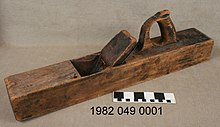The jointer plane, also known as the try plane or trying plane, is a type of hand plane used in woodworking to straighten the edges of boards in the process known as jointing, and to flatten the faces of larger boards.[2] Its long length is designed to 'ride over' the undulations of an uneven surface, skimming off the peaks, gradually creating a flatter surface. In thicknessing or preparing rough stock, the jointer plane is usually preceded by the fore plane or jack plane and followed by the smoothing plane.[2][3]
 A Stanley #7 jointer plane | |
 Wooden jointer from c.1880 | |
| Other names | Try plane Trying plane Trueing plane[1] |
|---|---|
| Used with | Jack plane and smoothing plane |
Jointer planes are typically 20 to 24 inches (510 to 610 mm) long, and are the longest hand planes commonly used.[2] Under the Stanley Bailey numbering system, #7 and #8 planes are jointer planes.[4]
The use of the name jointer plane dates back to at least the 17th century, referring to the process of readying the edges of boards for jointing.[5] The terms try plane, trying plane, and trueing plane have been in use since at least the 19th century.[3]
As with other hand planes, jointer planes were originally made with wooden bodies. But, since the development of the metal-bodied hand plane at the end of the 19th century, wooden-bodied jointers have been largely superseded. Metal-bodied planes are heavier, which is particularly noticeable for planes as large as jointers. This can make metal-bodied jointers more tiring to use for extended periods of time.[6]
See also
References
